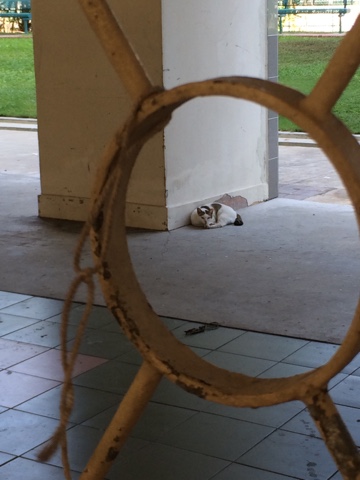http://www.latimes.com/local/california/la-me-adv-cats-for-hire-20150627-story.html
Like the characters played by the actor who inspired his name, Pacino was no scaredy cat. The brown tabby had prowled the streets of Los Angeles, a drifter scraping for his next meal.
After the cat was turned in at an L.A. County animal services shelter, there was little hope that Pacino would be adopted. He was too distrustful, too fierce, too mean.
Then Melya Kaplan came along, looking for a cat with grit, street smarts and attitude.
The 10-pound, 6-ounce cat would become the nighttime warden at the Original L.A. Flower Market, making sure rodents and other vermin didn't get out of hand. He's part of a group of tough cats recruited by an animal rights nonprofit to find homes in places that could use their hard-scrabble qualities. Along with another cat named DeNiro, Pacino would prowl the Italian side of the flower market. Of course.
"Mother Nature doesn't make mistakes," said Kaplan, executive director of Voice for the Animals. "We probably just haven't found a purpose for it yet."
As part of the Working Cats program, street cats like Pacino are rescued from animal shelters and sent to locations ranging from police stations, like the LAPD's Wilshire and Foothill divisions, to private homes, businesses and schools. Over the years, the program has placed about 500 cats in nearly 50 locations.
Kaplan, a frequent customer of the market, developed the program in 1999 when Carl Jones, a market employee, told her about the rats in the workplace. Exterminators would spray the warehouse with poison, but the vermin remained. Every so often, a customer would spot a pair of beady eyes hidden in the row of flowers.
"Anytime you heard a customer scream, you generally knew the rats were to blame. And then I had to stop what I was doing and go chase the little thing away," said Jones, who has worked at the market for 15 years. "It definitely wasn't the highlight of my job."
Scott Yamabe, executive vice president of the Original L.A Flower Market, said the facility had battled rats since the beginning of the 20th century. All kinds of things were tried to get rid of the rats, but the results were always the same: nibbled-on flowers.
"The rodents even chewed through the wooden refrigerator doors where we kept the flowers," said Yamabe. "Those rats were too smart. We really needed help."
About 15 years ago, Kaplan made a proposition to Yamabe. She would deliver three cats to the flower market to get rid of the rats. And if they could not take care of the rodents, she would take them back.
The market currently has 15 cats, and Jones and Yamabe said they do not see any rats.
cComments
ADD A COMMENTSEE ALL COMMENTS
- Cats are not part of nature. They are decimating wildlife that has been around for millions of years. If they are in an enclosed area for rodent control that is fine, as that is what they were selectively bred for. To turn them out on the streets is most damaging to the ecosystem. Cats are...TIELZ1AT 8:09 PM JUNE 27, 2015
Kaplan attributes the program's success to the simple fact that adding a predator to an environment will scare away its prey. Once rodents smell a cat on the prowl, they go somewhere else, she said.
"It's not anything new. People used to have barn cats or church cats to keep out rodents," Kaplan said. "We just brought [it] to the city, and it seems to be really working."
Yamabe remembered one gray cat that died after several years of service patrolling the second-floor parking lot. Within days, the rats returned and Yamabe needed to call for another cat.
"It was unbelieveable. The rats returned like they never left," Yamabe recalled. "And they disappeared just as fast when a new cat appeared. Those cats make a real difference."
On a recent day, a cream and white cat hid behind an iron grate door during business hours. Its two eyes stood out from a darkened corner while a patron passed with petunias. The cats can be difficult to spot during the day because most are still shy around people.
For a cat like Pacino, living in a warehouse almost certainly adds years to his life. Living on the streets is tough on any sentient being, including a cat. Kaplan said cats that might have lived fewer than five years on the streets can live more than 14 years in a home, business or police station. They're given meals and the buildings give them protection from bad weather, dogs and cars.
And for cats that lived most of their lives on the street before ending up in a shelter, a program like Working Cats can be a lifesaver, Kaplan said. It's not easy to find adoptive homes for cats, and that's especially true of those that have not been socialized around humans. In 2014, L.A. County euthanized nearly 19,000 cats, about 70% of those that entered shelters.
Kaplan said that in time, some of her more veteran cats got used to being around people and became house cats. That, in turn, created space for other cats to be rescued by the program.
"We're saving cats and helping people. And it's always great when the two grow closer together and we can place another cat," she said. "It's what I call a win-win-win."
























































 and Wisdom
and Wisdom
